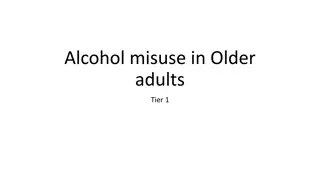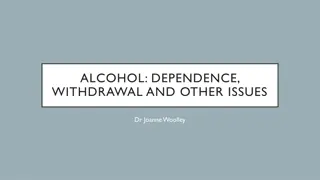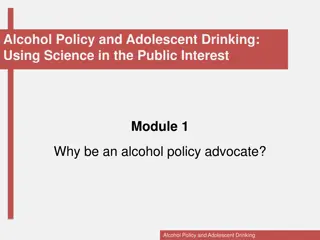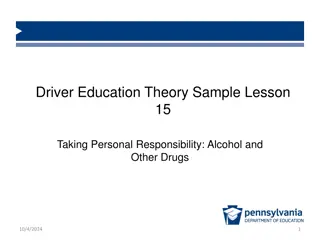Effects of Alcohol on Driving and Health
Understanding the effects of alcohol on driving is crucial to prevent accidents. Alcohol impairs driving ability by affecting reaction time, coordination, balance, vision, and judgment. Myths and facts about alcohol consumption, such as the misconception about beer being less intoxicating, are debunked. Factors like blood alcohol concentration and the risks associated with different BAC levels are highlighted to emphasize the importance of not driving under the influence.
Download Presentation

Please find below an Image/Link to download the presentation.
The content on the website is provided AS IS for your information and personal use only. It may not be sold, licensed, or shared on other websites without obtaining consent from the author.If you encounter any issues during the download, it is possible that the publisher has removed the file from their server.
You are allowed to download the files provided on this website for personal or commercial use, subject to the condition that they are used lawfully. All files are the property of their respective owners.
The content on the website is provided AS IS for your information and personal use only. It may not be sold, licensed, or shared on other websites without obtaining consent from the author.
E N D
Presentation Transcript
DRINKING, DRUGS, and HEALTH Chapter 6
OBJ: Identify the effects of alcohol and drinking and driving Do Now! What is the only thing that can make a person sober?
The only thing that can make a person sober TIME! *True or false activity
Myths vs Facts Myth: Alcohol is a stimulant Fact: Alcohol is a central nervous system depressant. Although the initial effects may be euphoric and seem stimulating, alcohol slows down the brain activity- the ability to make good judgments MYTH: Beer is less intoxicating than other types of alcoholic beverage. FACT: One 12-ounce can of beer, one 5- ounce glass of wine or 1.5-ounce liquor MYTH: Switching between beer, wine, and liquor will make you drunker. FACT: Mixing types of drinks may make you sicker by upsetting your stomach, but not more intoxicated. Alcohol is alcohol. MYTH: Cold Showers, fresh air or hot coffee help sober a person. FACT: Only time will remove alcohol from the system. It takes the body approximately one hour to eliminate the alcohol in one drink. An old saying goes, "give a drunk a cup of coffee and all you have is a wide-awake drunk. MYTH: Eating a big meal before you drink will keep you sober. FACT: Drinking on a full stomach will only delay the absorption of alcohol into the bloodstream, not prevent it. Eating before you drink is not a defense against getting drunk. MYTH: Everyone reacts to alcohol in the same way. FACT: Many factors that affect a person's reaction to alcohol body weight, metabolism, gender, body chemistry, and many others.
Effects of Alcohol Alcohol is a depressant Effects overall driving ability Unrealistic overconfidence in driving ability Unable to think clearly Makes more mistakes while driving Driving under the influence means that a drivers senses and judgement are impaired by alcohol Reaction time Coordination Balance Vision Ability to judge distance flip flop
How Much is Too Much? BAC = Blood alcohol concentration BAC is determined by 4 factors Quantity of alcohol consumed Body weight How quickly drinks are consumed Food eaten Factors The best way to reduce the risk of a crash caused by drinking and driving is not to drive at all after drinking
How Much is Too Much? Illegal BAC 21 years or older illegal BAC - .08 % or higher Younger than 21 illegal BAC - .01 % or higher RISK BAC of .05 % risk for causing an accident DOUBLES BAC of .10% risk for causing an accident SIX TIMES BAC of .15% risk for causing accident 25 TIMES Refusal to take a breath test is equal to driving with a BAC of .10% -results in $1,000 per year surcharge for 3 years
How BAC Effects Driving .02%: reaction is slow and poor .05%: driving skills noticeably deteriorate Muscles too relaxed Coordination decreased .08%: Chance of crash climbs rapidly Judgment and inhibition are affected Coordination, balance, vision, hearing and speech .1%: crash dramatically increases Mental/physical skills are extremely effected Hard to walk- stumble .2%: most people will loose consciousness .3%: pass out while driving: coma: death
One Drink Equals 1.5 oz 86 proof liquor 12 oz beer 5 oz wine Every drink contains about a ounce of alcohol. It is not what you drink, but how many drinks you have *EATING does not make a motorist sober
Drinking and Driving Law enforcement is trained to notice certain telltale signs that a motorist has been drinking Speeding- an intoxicated driver often thinks high speed driving is safe Weaving- Even though an intoxicated driver may stay in the correct lane, driving straight may be a problem Slow driving- an intoxicated driver often may be overly cautious and drive slower then the normal traffic flow Jerking motion- an intoxicated driver often may have short mental lapses and not keep a steady speed on a clear road Quick Stops- an intoxicated driver may make sudden stops at a traffic sign or light, rather than easing up to it.
Get the Facts 2 out of 5 in the US will be involved in alcohol-related collision Your chances of getting into a car crash are 7x greater than when you are sober The risk of a DWI related crash is 3x higher at night (10:00-1:00am) weekdays, 1 in 7 drivers is DWI Midnight to 3am Saturday is the DEADLYIST time to drive There is approximately one fatal alcohol-related motor vehicle crash every 30 minutes Traffic crashes are leading cause of death for under 25 More than half are alcohol related
Good Hosts and the Drinking Driver Stop serving alcohol well before the party ends If someone drinks too much, don't let them drive Hosts may become involved in a lawsuit if a guest is involved in a drinking and driving collision after leaving the party DUI
Designated Drivers NJ encourages all state residents to participate in designated driver programs The designated driver is responsible for the safe transportation of friends or family members who have been drinking alcoholic beverages. Nextshark Arianna
Drugs and Driving It is illegal to operate a motor vehicle under the influence of ANY ILLEGAL DRUGS Do not take prescription drugs that may cause drowsiness before driving Never mix medications Drugs that may affect basic driving skills include cold pills, tranquilizers and some prescription medication.
Drugs and Driving After alcohol, marijuana is the drug most often found with drivers involved in collisions. Marijuana may affect driving in the following ways: Loss of tracking ability: maintain a vehicle in a line Distance judgment Vigilance: not remaining attentive Divided attention
Summarizer _________ liquor = ________ wine = _________ beer
DRIVING PRIVILEDGES AND PENALTIES Chapter 7
OBJ: Identify driving penalties Do Now Refusal to take a breathe test is equal to driving with a BAC of ________and will result in penalties that go along with driving at ________ This law is called?
Do Now answer Refusal to take a breathe test is equal to driving with a BAC of .10% and will result in penalties that go along with driving at .10% Implied consent law
Penalties In NJ a person must be 21 to purchase, possess or consume alcoholic beverages. Underage drinking is illegal and can have severe consequences for people who drink underage and parents who provide alcohol for those under 21 Under 21 and buys or drinks alcohol Fined $500 Lose license for 6 months If the person does not have a license, they will wait and lose when they first are set to receive their license Alcohol education or treatment program Underage DUI loss license 30-90 days (under .08%)
Mandatory Penalties 21 or over First offense/BAC .08% or more but less than .10% 3-month suspension of driving privilege $250 to $400 fine 12- to 48-hour participation in an (IDRC) $230 per day IDRC fee Up to 30 days imprisonment $100 Drunk Driving Enforcement Fund $100 (AERF) Alcohol Education and Rehabilitation Fund $1,000 annual surcharge for three years $75 Safe Neighborhood Services Fund Possible interlock device requirement for six months to one year
Mandatory Penalties First Offense/BAC .10% or more 7-month to 1-year suspension of driving privilege $300 to $500 fine 12- to 48-hour participation in (IDRC) $230 per day IDRC fee Up to 30 days imprisonment $100 Drunk Driving Enforcement Fund fee $100 Alcohol Education, Rehabilitation and Enforcement Fund fee $1,000 annual surcharge for three years $75 Safe Neighborhood Services Fund fee Possible interlock device requirement for six months to one year
Other Reason For License Loss Failure to appear in court to pay fines. Failure to pay surcharges. Driving while license is suspended. No insurance/no registration. Drug or alcohol use. Repeated traffic law violations.
Breathe Test NJ has a implied consent law NJ motorists have agreed to submit to a breath test given by law enforcement following an arrest for a drinking and driving offense. Refusal- subject to a violation $1,000 per year for 3 years Equal to driving with BAC of .10% breathalyzer How it works
Ignition Interlock Device First DUI offense Device for 6 months or 1 year Court ordered device attached to the vehicle with a built-in breathalyzer. Second DUI offense Device for 1-3 years/or 2 yrs suspension o privileges Device for 1-3 yrs or 10 yr suspension of privileges Vehicle is prevented from starting f the motorists BAC exceeds .05 percent. Interlock Device Third DUI offense Device Video
Driver Programs 1) Driver Improvement Program A Motorists who accumulate between 12 and 14 points in a 24-month period will receive a Notice of Scheduled Suspension by mail from the MVC a. Attend NJ driver improvement program; or b. Ask for a hearing; or c. Turn your license for the suspension period. d. 3 points removed if successfully completed. e. Once completed, you will be on probation for 1 year 2) Defensive Driving Program a. Deduct 2 points after successfully completing. (Only 1 course every 5 years) b. Insurance will decrease.
Driver Programs 3. Probationary Driver Program purpose is to correct improper driving tactics while a driver still has their permit or provisional/examination license. a. Must enroll if convicted of 2 or more moving violations with 4 or more points within probation period. b. Completion of this program will result in a three-point reduction on an individual motorist s history record
Insurance Surcharges *If you get 6 or more points in 3 years or less: -subject to insurance surcharge of $150 for 6 points and $25 for each additional point. *Unlicensed Driver = $100 surcharge. *No Liability Insurance = $250 surcharge. Failure to pay surcharge = Indefinite Suspension
Point System The MVC keeps track of a motorists driving record by adding points to the record when a motorist is convicted of a violation. The more serious the violation, the more points given. Motor vehicle can track your driving record through point system. 12 points and license is suspended +2 points = violations from other states. -3 points=each year a driver is violation free. Point total never goes below 0 .
Moving Violations (page 124 manual) Driving on private property .2pts. Failure to yield to passing vehicle ...2pts. Failure to yield to pedestrians ..2pts. Improper turns ..3pts. Speeding:15-29 mph above limit .4pts. Improper passing of school bus ...5pts. Racing on highway/reckless driving 5pts. Leaving scene of accident (injury) ... 8pts.
Motor Vehicle Violations Driving privileges will be post-poned or suspended to any unlicensed person 13-21 convicted of graffiti If you are involved in a motor vehicle accident that causes injury to others, while your driving privileges are suspended, you are subject to a fine, continued suspension, and jail time Driving with an open container first offense $200
Restoring License *Any violation after completing Driver Improvement or Probationary Driver programs will result in your license being suspended. *Length of suspension will depend on how soon you break a traffic law after MVC restores your license. *$100 to restore your license.
Habitual Offender A person with 3 license suspensions for violations that happened within 3 years, may lose his/her license for up to 3 years. There are no conditional or special work licenses in New Jersey. If you lose your license for a drunk driving or any other violation, you may not drive regardless of the type of job that you have, until your suspension ends .NO EXCEPTIONS!!
Summarizer Must enroll in a probationary driver program if convicted of ___________________________________ _________________________
Answer 2 or more moving violations with 4 or more points within probation period.
EXTRA CREDIT You will be able to create a PSA to raise awareness about the negative effects of drinking and driving. Background Public Service Announcements, PSA s, are a way of sharing important health information with the public through the media. PSA s are designed to get people s attention, provide information, or to influence the general population s attitudes toward a certain topic. PSA s quickly increase awareness or generate interest to a certain cause or condition. The most effective PSA s are deliberately designed to catch the public s eye and are memorable. Video
Videos prom if you drink, don't drive Jacqueline Prom























